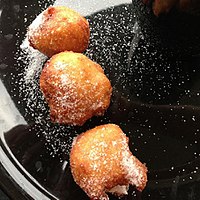| It has been suggested that this article be merged into Mandazi. (Discuss) Proposed since December 2024. |
| This article needs additional citations for verification. Please help improve this article by adding citations to reliable sources. Unsourced material may be challenged and removed. Find sources: "Puff-puff" – news · newspapers · books · scholar · JSTOR (January 2023) (Learn how and when to remove this message) |
 | |
| Type | Doughnut |
|---|---|
| Course | snack |
| Place of origin | Nigeria |
| Main ingredients | Flour, yeast, sugar, salt, butter, water, eggs, vegetable oil |
| Variations | Boflot, kala, mikate, togbei, beignet dougoup |
Puff-puff is a traditional snack made of fried dough and eaten across Africa, especially in the west of the continent. The name "puff-puff" is from Nigeria, but many other names and varieties of the pastry exist (see below).
Puff-puffs are generally made of dough containing flour, yeast, sugar, butter, salt, water and eggs (which are optional), and deep-fried in vegetable oil to a golden-brown color. Baking powder can be used as a replacement for yeast, but yeast is a better option. After frying, puff-puffs can be rolled in sugar. Like the French beignet and the Italian zeppole, puff-puffs can be rolled in any spice or flavoring such as cinnamon, vanilla and nutmeg. They may be served with a fruit dip of strawberry or raspberry.
Varieties and other names
In Francophone West Africa it is known as gato in Guinea and Mali (from the French gateau) and beignet in Senegal and Cameroon, as well as in The Gambia. A common Senegalese variety uses millet flour rather than wheat. Cameroonians accompany beignets with beans.
Other names for the dish include buffloaf (or bofrot) in Ghana, botokoin in Togo, bofloto in the Ivory Coast, mikate in Congo, micate or bolinho in Angola, fungasa in Chad, legemat in Sudan, kala in Liberia, and vetkoek, amagwinya, or magwinya in South Africa and Zimbabwe. The prominence of this dish stretches even to the southern and eastern edges of Africa, where it is mostly known as mandazi.
An extremely similar dish can be found in Tonga, where it is known as keke ʻisite (literally, yeast cake). The recipe is almost identical to that of puff-puff; however, it is sometimes fried in shortening or dripping instead of vegetable oil.
See also
- Lokma
- Bolinho de chuva
- Boortsog
- Buñuelo
- Chin chin
- Gulab jamun
- Kuli-kuli
- List of doughnut varieties
- Loukoumades
- Oliebol
- Beignet
References
- "The puff-puff: A Nigerian delicacy".
- ^ "How To Make Puff Puff". Zikoko!. 2021-07-24. Retrieved 2021-09-13.
- "Beignets dougoub (beignets de mil soufflés)". Senecuisine. 10 May 2018. Retrieved 25 May 2023.
- "Nigerian Food Recipes TV| Nigerian Food blog, Nigerian Cuisine, Nigerian Food TV, African Food Blog: Nigerian Puff Puff Recipe : How to make Puff puff". Nigerianfoodtv.com. 11 October 2012. Retrieved 2016-01-11.
- "Keke 'Isite". The Coconet.tv. Retrieved 2024-12-17.
Further reading
- Akubor, Peter (April 2004). "Protein contents, physical and sensory properties of African snack foods (cake, chin-chin and puff-puff) prepared from cowpea-wheat flour blends". International Journal of Food Science & Technology. 39 (4): 419. doi:10.1111/j.1365-2621.2004.00771.x.
- Patent, Greg. A Baker's Odyssey: Celebrating Time-Honored Recipes from America's Rich Immigrant Heritage.
| Doughnuts, fritters and other fried-dough foods | |||||
|---|---|---|---|---|---|
| Sweet | |||||
| Savory |
| ||||
| Companies | |||||
| Lists | |||||
| See also |
| ||||
